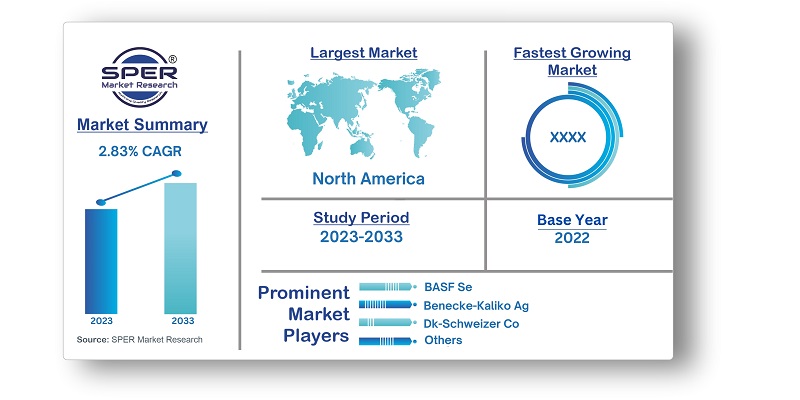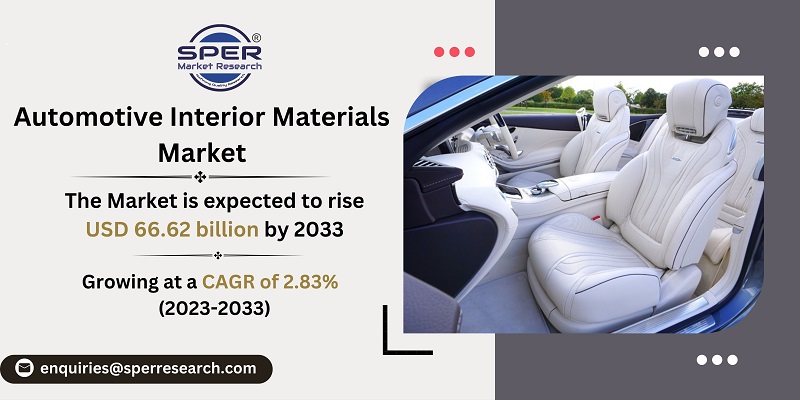
Automotive Interior Materials Market Growth, Size, Trends, Scope, Revenue and Future Challenges
Automotive Interior Materials Market Size- By Type, By Vehicle Type, By Application- Regional Outlook, Competitive Strategies and Segment Forecast to 2033
| Published: Jul-2023 | Report ID: AMIN23114 | Pages: 1 - 245 | Formats*: |
| Category : Automotive & Transportation | |||
- Increasing Vehicle Production: The expansion of the market for car interior materials is strongly related to the entire volume of vehicles produced. There is an ongoing need for interior materials to outfit cars due to the increased demand for automobiles globally, especially in emerging economies. The demand for interior materials is driven by the growth of production facilities and the launch of new vehicle models.
- Evolving Consumer Preferences: Customers are increasingly looking for cars with fashionable and cosy interiors. By providing a variety of alternatives, such as premium leather, fine textiles, and cutting-edge synthetic materials, automotive interior materials play a key part in satisfying these tastes. Manufacturers are concentrating on creating materials that improve aesthetics and offer a comfortable and opulent indoor ambiance.

- Opportunities for Automotive Interior Materials market can be: Growing Demand for Premium and Luxury Vehicles: The demand for premium and luxury automobiles is expanding as a result of customers' increased wealth and ambitions. These cars often have opulent interiors that are of a high calibre, which presents chances for suppliers of high-end materials like exquisite leather, exotic woods, and innovative fabrics.
- Electric Vehicle (EV) Market Expansion: Automotive interior materials have a chance because of the expanding market for electric automobiles. In order to create interiors that are both futuristic and environmentally friendly, EV producers must use novel materials that are both lightweight and environmentally friendly and include cutting-edge technology like touchscreens and digital displays.
- Some of the major challenges faced by the Automotive Interior Materials market are: Cost Pressure: Cost pressures are a common issue for automotive manufacturers, who look for economical solutions for their interior parts. This makes it difficult for suppliers of interior materials to strike a balance between price, functionality, and quality while still satisfying the demanding standards of automakers.

| Report Metric | Details |
| Market size available for years | 2019-2033 |
| Base year considered | 2022 |
| Forecast period | 2023-2033 |
| Segments covered | By Type, By Vehicle Type, By Application |
| Regions covered | Asia-Pacific, Europe, Middle East and Africa, North America, Latin America |
| Companies Covered | BASF Se, Benecke-Kaliko Ag, Borgers Se & Co. Kgaa, Dk-Schweizer Co., E.I. Du Pont De Nemours & Co., Eagle Ottawa Llc, Faurecia Automotive Gmbh, Johnson Controls Inc., Katzkin Leather Inc., Lear Corporation, Sage Automotive Interiors Inc., The Dow Chemical Company |
- Aftermarket Distributors and Retailers
- Automotive Industry Associations
- Automotive Interior Material Suppliers
- Automotive Manufacturers
- Design and Engineering Teams
- Investors and Financial Institutions
- Regulatory Authorities and Safety Organizations
- Research and Development Centres
| By Type : |
|
| By Vehicle Type : |
|
| By Application : |
|
- Global Automotive Interior Materials Market Size (FY’2023-FY’2033)
- Overview of Global Automotive Interior Materials Market
- Segmentation of Global Automotive Interior Materials Market By Type (Composite, Fabric, Leather, Metals, Plastic, Others)
- Segmentation of Global Automotive Interior Materials Market By Vehicle Type (Heavy Commercial Vehicle, Light Commercial Vehicle, Passenger Vehicle)
- Segmentation of Global Automotive Interior Materials Market By Application (Airbags & Seat belts, Carpet and headliners, Dashboard, Door panel & trims, Seats, Others)
- Statistical Snap of Global Automotive Interior Materials Market
- Expansion Analysis of Global Automotive Interior Materials Market
- Problems and Obstacles in Global Automotive Interior Materials Market
- Competitive Landscape in the Global Automotive Interior Materials Market
- Impact of COVID-19 and Demonetization on Global Automotive Interior Materials Market
- Details on Current Investment in Global Automotive Interior Materials Market
- Competitive Analysis of Global Automotive Interior Materials Market
- Prominent Players in the Global Automotive Interior Materials Market
- SWOT Analysis of Global Automotive Interior Materials Market
- Global Automotive Interior Materials Market Future Outlook and Projections (FY’2023-FY’2033)
- Recommendations from Analyst
1.1. Scope of the report1.2. Market segment analysis
2.1. Research data source2.1.1. Secondary Data2.1.2. Primary Data2.1.3. SPER’s internal database2.1.4. Premium insight from KOL’s2.2. Market size estimation2.2.1. Top-down and Bottom-up approach2.3. Data triangulation
4.1. Driver, Restraint, Opportunity and Challenges analysis4.1.1. Drivers4.1.2. Restraints4.1.3. Opportunities4.1.4. Challenges4.2. COVID-19 Impacts of the Global Automotive Interior Materials Market
5.1. SWOT Analysis5.1.1. Strengths5.1.2. Weaknesses5.1.3. Opportunities5.1.4. Threats5.2. PESTEL Analysis5.2.1. Political Landscape5.2.2. Economic Landscape5.2.3. Social Landscape5.2.4. Technological Landscape5.2.5. Environmental Landscape5.2.6. Legal Landscape5.3. PORTER’s Five Forces5.3.1. Bargaining power of suppliers5.3.2. Bargaining power of buyers5.3.3. Threat of Substitute5.3.4. Threat of new entrant5.3.5. Competitive rivalry5.4. Heat Map Analysis
6.1. Global Automotive Interior Materials Market Manufacturing Base Distribution, Sales Area, Product Type6.2. Mergers & Acquisitions, Partnerships, Product Launch, and Collaboration in Global Automotive Interior Materials Market
7.1. Global Automotive Interior Materials Market Value Share and Forecast, By Type, 2023-20337.2. Composite7.3. Fabric7.4. Leather7.5. Metals7.6. Plastic7.7. Others
8.1. Global Automotive Interior Materials Market Value Share and Forecast, By Vehicle Type, 2023-20338.2. Heavy Commercial Vehicle8.3. Light Commercial Vehicle8.4. Passenger Vehicle
9.1. Global Automotive Interior Materials Market Value Share and Forecast, By Application, 2023-20339.2. Airbags & Seat belts9.3. Carpet and headliners9.4. Dashboard9.5. Door panel & trims9.6. Seats9.7. Others
10.1. Global Automotive Interior Materials Market Size and Market Share
11.1. Global Automotive Interior Materials Market Size and Market Share By Type (2019-2026)11.2. Global Automotive Interior Materials Market Size and Market Share By Type (2027-2033)
12.1. Global Automotive Interior Materials Market Size and Market Share By Vehicle Type (2019-2026)12.2. Global Automotive Interior Materials Market Size and Market Share By Vehicle Type (2027-2033)
13.1. Global Automotive Interior Materials Market Size and Market Share By Application (2019-2026)13.2. Global Automotive Interior Materials Market Size and Market Share By Application (2027-2033)
14.1. Global Automotive Interior Materials Market Size and Market Share By Region (2019-2026)14.2. Global Automotive Interior Materials Market Size and Market Share By Region (2027-2033)14.3. Asia-Pacific14.3.1. Australia14.3.2. China14.3.3. India14.3.4. Japan14.3.5. South Korea14.3.6. Rest of Asia-Pacific14.4. Europe14.4.1. France14.4.2. Germany14.4.3. Italy14.4.4. Spain14.4.5. United Kingdom14.4.6. Rest of Europe14.5. Middle East and Africa14.5.1. Kingdom of Saudi Arabia14.5.2. United Arab Emirates14.5.3. Rest of Middle East & Africa14.6. North America14.6.1. Canada14.6.2. Mexico14.6.3. United States14.7. Latin America14.7.1. Argentina14.7.2. Brazil14.7.3. Rest of Latin America
15.1. BASF Se15.1.1. Company details15.1.2. Financial outlook15.1.3. Product summary15.1.4. Recent developments15.2. Benecke-Kaliko Ag15.2.1. Company details15.2.2. Financial outlook15.2.3. Product summary15.2.4. Recent developments15.3. Borgers Se & Co. Kgaa15.3.1. Company details15.3.2. Financial outlook15.3.3. Product summary15.3.4. Recent developments15.4. Dk-Schweizer Co.15.4.1. Company details15.4.2. Financial outlook15.4.3. Product summary15.4.4. Recent developments15.5. E.I. Du Pont De Nemours & Co.15.5.1. Company details15.5.2. Financial outlook15.5.3. Product summary15.5.4. Recent developments15.6. Eagle Ottawa Llc15.6.1. Company details15.6.2. Financial outlook15.6.3. Product summary15.6.4. Recent developments15.7. Faurecia Automotive Gmbh15.7.1. Company details15.7.2. Financial outlook15.7.3. Product summary15.7.4. Recent developments15.8. Johnson Controls Inc.15.8.1. Company details15.8.2. Financial outlook15.8.3. Product summary15.8.4. Recent developments15.9. Katzkin Leather Inc.15.9.1. Company details15.9.2. Financial outlook15.9.3. Product summary15.9.4. Recent developments15.10. Lear Corporation15.10.1. Company details15.10.2. Financial outlook15.10.3. Product summary15.10.4. Recent developments15.11. Sage Automotive Interiors Inc.15.11.1. Company details15.11.2. Financial outlook15.11.3. Product summary15.11.4. Recent developments15.12. The Dow Chemical Company15.12.1. Company details15.12.2. Financial outlook15.12.3. Product summary15.12.4. Recent developments15.13. Others
SPER Market Research’s methodology uses great emphasis on primary research to ensure that the market intelligence insights are up to date, reliable and accurate. Primary interviews are done with players involved in each phase of a supply chain to analyze the market forecasting. The secondary research method is used to help you fully understand how the future markets and the spending patterns look likes.
The report is based on in-depth qualitative and quantitative analysis of the Product Market. The quantitative analysis involves the application of various projection and sampling techniques. The qualitative analysis involves primary interviews, surveys, and vendor briefings. The data gathered as a result of these processes are validated through experts opinion. Our research methodology entails an ideal mixture of primary and secondary initiatives.



Frequently Asked Questions About This Report
PLACE AN ORDER
Year End Discount
Sample Report
Pre-Purchase Inquiry
NEED CUSTOMIZATION?
Request CustomizationCALL OR EMAIL US
100% Secure Payment






Related Reports
Our Global Clients
Our data-driven insights have influenced the strategy of 200+ reputed companies across the globe.






















